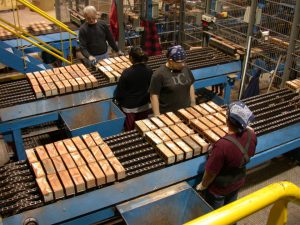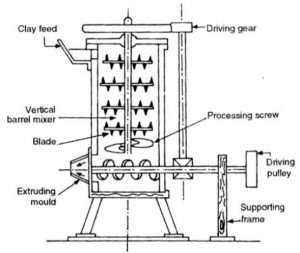Manufacturing of Bricks
Manufacturing of Bricks
1.PREPARATION OF BRICK-EARTH
Following steps are involved in preparing Brick-earth.
a. Digging
If the area from where soil is to be taken is grassy or has other vegetation then the top layer (about 20 cm deep) is excavated and thrown away as it contains roots of vegetation and other organic matter. The excavated lumps of soil are broken. It is ensured that the soil is free from gravel, coarse sand, lime and kankar particles, vegetable matter etc.
b. Weathering
Excavated soil, after the lumps have been broken, is mixed with a little water and is left in heaps to weather for a period varying from a few weeks to as long as it can be left. This improves its plasticity and strength. To keep the soil wet water may be sprayed on the heap from time to time and the heap turned over.
c. Blending
The earth is then thoroughly broken and mixed with sandy soil if needed. The whole mass is thoroughly mixed up and reasonable amount of water is added if needed.
d. Tempering
Blended soil is kneaded under the feet of men or cattle after desired quantities of water have been added to it. The whole mass becomes homogeneous and plastic. It is then left covered with mats and allowed to dry gradually in layers about 30 cm thick for not less than 36 hours, till it is just soft enough for moulding, pug mill is used for tempering earth needed for the manufacture of bricks either on large scale or for use on superior works like arches etc.
e. Moulds
Moulds are rectangular boxes of wood or steel without top bottom and the longer sides projecting a few centimetres to act as handles. The edges of the wooden moulds should be protected with strips of brass or steel screwed on them. Steel moulds keep their shapes and last longer than the wooden moulds and are used for heavy works. Inside dimensions of the moulds are kept a little larger than the size of burnt brick (generally about 1/10th of the size of brick each way). It is done to allow for the shrinkage of the moulded brick on drying and burning. The exact allowance to be made for shrinkage can be ascertained by field tests.

1. Manufacturing of Bricks
2. Moulding of Bricks
3. Drying of Bricks
4. Burning of Bricks
5. Hoffmann’s kiln and Bull’s trench kiln
Manufacturing of Bricks, Manufacturing of Bricks, Manufacturing of Bricks, Manufacturing of Bricks, Manufacturing of Bricks, Manufacturing of Bricks, Manufacturing of Bricks, Manufacturing of Bricks,


THANK YOU BUTIFUL KNOWLEDGE.
welcome